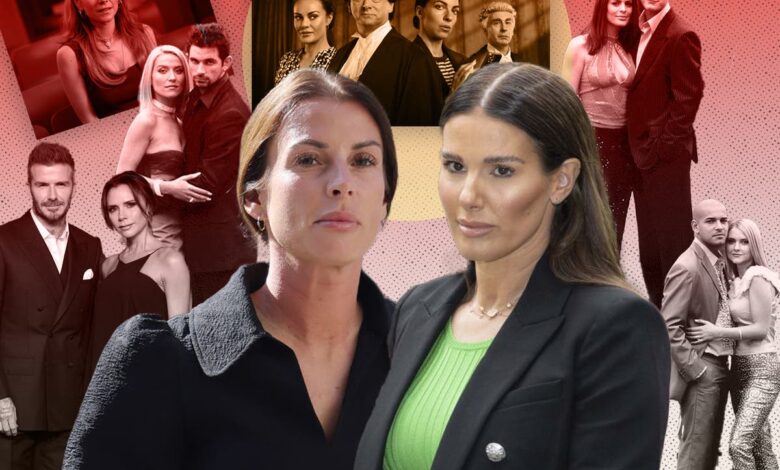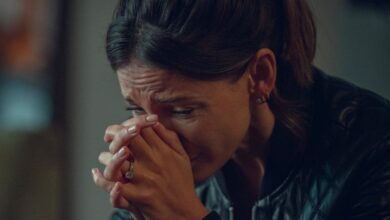‘The transcripts were absolutely unbelievable’: The dramatisation of Vardy v Rooney and why TV just loves WAGs

At 10.29am on 9 October 2019, Coleen Rooney posted a statement on Twitter. It was crafted with all the narrative tension and dramatic flair of a classic whodunnit. “For a few years now,” it read, a follower on her private Instagram account had been sharing details of her posts with The Sun newspaper. After puzzling over the case for “a long time”, she developed a hunch as to “who it could be” – to prove it, she constructed a simple but dazzlingly effective social media sting operation.
Rooney, the wife of former England captain Wayne, blocked all but one account from viewing her Instagram Stories, then cooked up a handful of fake news titbits: one claimed she was considering flying to Mexico to investigate gender selection treatment, another hinted at a return to TV and a third bemoaned a (fictional) flood at the Rooneys’ new home. These stories made their way into the pages of The Sun – and Coleen “saved and screenshotted all the original stories, which clearly show[ed] just one person viewed them”. Then came the devastating reveal, the suspense soaring with every additional dot in her elongated ellipsis: “It’s………. Rebekah Vardy’s account.”
Soon, Rooney’s detective work was everywhere, from Twitter memes (including the first coinage of “Wagatha Christie”, which would soon become tabloid shorthand for this war of WAGs) to the pages of the broadsheets. Vardy, married to Leicester City star Jamie, would deny the accusations vehemently and indelibly. “Arguing with Coleen is like arguing with a pigeon,” she told the Daily Mail soon after. “You can tell it that you are right and it is wrong but it’s still going to s*** in your hair.”
Vardy launched a high court libel case, and details began to emerge: a phone belonging to her agent Caroline Watt mysteriously ended up at the bottom of the North Sea. Over the course of seven days in May, the two women went head-to-head in room 13 of the Royal Courts of Justice; two months later, Mrs Justice Steyn ruled in Rooney’s favour.
Inevitably, the “Wagatha” saga is now the subject of a TV show, Vardy v Rooney: A Courtroom Drama, which was dramatised from actual court transcripts, and will air on Channel 4 later this week. “No one could watch this [case] – everyone was just getting this kind of live stream from the journalists who were in the courtroom,” executive producer Tom Popay explains. “It was all so sensational, so we were like, ‘Well, what kind of new stuff would we learn if we fully recreated the trial?’ We sent off for the transcripts and when they came… they were absolutely unbelievable. We realised that all the tweets and reports from the trial had just scratched the surface.”
Our obsession with WAGs might seem enjoyably trivial on the surface, yet delve a little deeper and you soon start to unravel a nexus of cultural hot topics: football, yes, but also tabloid media, money and, crucially, class. No wonder TV keeps returning to these women.
To get to the heart of this very British phenomenon, we need to rewind three decades. In 1992, the FA launched the Premier League, the highest level of the men’s professional game contested by the top 20 clubs in English football, and money flooded into the sport through lucrative media contracts. The average weekly wage of a Premier League player in 1993 was £2,246, according to the website Sporting Intelligence; by 1998, at the end of Sky TV’s first five-year deal with the Premier League, it had more than tripled to £7,136. By 2019, it stood at around £61,000 a week, a number that had risen more than £10,000 in the two preceding years (according to Statistica, players at Rooney’s old club now enjoy the highest average salaries in the Premier League, receiving an average of £7.19m annually).
Footballers and their partners became synonymous with a lavish, flashy lifestyle, in tandem with “the rise of celebrity magazines”, notes Helen Wood, professor of media and cultural studies at Lancaster University. The likes of OK! (launched in 1993) and Heat (which followed in 1999) devoted their pages to “young women with spending power”, at a time when “girl power” rhetoric had major cultural currency, celebrating “women who want to have more, [and] do it their way”.
Many of the early WAGs – such as Louise Redknapp, Dani Behr and Ulrika Jonsson, high-profile partners of Jamie Redknapp, Ryan Giggs and Stan Collymore– were famous in their own right. They became “very powerful in media terms”, Wood explains, “because they’re spectacular, they look good, they’re in all the right places” – and were very good at spending money. “It was a power through consumption, rather than power that can make any social or political change,” she adds.
The biggest proponents of “girl power”, of course, were the Spice Girls – and in 1999, Victoria Adams, aka Posh Spice, supercharged the WAG game when she married David Beckham. The couple received a rumoured £1m from OK! for their wedding pictures (including an unforgettable shot of the de facto king and queen of UK showbiz sitting on matching velvet thrones).
Against this backdrop, TV execs scrambled for ways to cash in on the phenomenon. Sky One launched Dream Team, a soapy drama based around fictional Premier League club Harchester United in 1997, but it was Footballers’ Wives, which debuted in 2002, that would really capture the public’s imagination. Focusing on the off-pitch antics of the WAGs of another fictional club, Earls Park, the ITV series had a simple but effective premise: it was all about “young people with loads of money and very little sense, and those scrapes they can then get into on a very dramatic scale”, co-creator Maureen Chadwick says.
The first season revolved around three couples, each rooted in different tabloid archetypes. There was golden boy Kyle Pascoe (Gary Lucy) and his glamour model fiancée Chardonnay (Susie Amy); new signing Ian Walmsley (Nathan Constance) and his childhood sweetheart Donna (Katherine Monaghan); and captain Jason Turner (Cristian Solimeno) and his Machiavellian wife Tanya (Zöe Lucker), whose increasingly melodramatic schemes to keep her husband in a job (and herself in a marriage) were fuelled by a heady cocktail of pre-match G&Ts, cocaine and immaculately applied fake tan.
Footballers’ Wives, Chadwick explains, was always intended as “satire”, but “some snooty male journalists” couldn’t get their heads around the possibility of two women deliberately writing a witty series set in the world of sport. “[They] thought that Anne [McManus, the show’s co-creator] and I didn’t know that it was funny,” she recalls. “They thought that we were accidentally funny.” The show’s tone may have been cartoonish, but it also managed to capture what composer Kath Gotts, who has turned the larger-than-life events of the drama’s first season into stage show Footballers’ Wives: The Musical with Chadwick, describes as “the precariousness of this world with loads of money and instant glamour”.
“Footballers have got a career until they break an ankle or something,” she says. “There’s a kind of ‘on edge-ness’ about that, and also for the partners, the wives and girlfriends.” They, like Tanya, constantly grapple with the threat of being replaced by a younger, prettier model. “You have that tension in a relationship, the power balance of ‘we’re a team until maybe, suddenly, we’re not’.”
Some critics might not have immediately got Footballers’ Wives, but the media eventually backed it in a big way. In a meta twist, OK! “covered” the christening of Kyle and Chardonnay’s baby “on the front page” in January 2003, and “treated it as real life”, Chadwick says. The Guardian, meanwhile, ran a piece by Germaine Greer, who praised how the show put “the female gaze behind the camera – we saw all the footballers naked… that scrutiny of the men’s bodies is definitely something we strove to achieve, so that it wasn’t just looking at the women’s enhanced tits or anything like that”.
The couples at the centre of ‘Footballers’ Wives’
The viewing public lapped it all up: by the time season two came around, Footballers’ Wives drew in the same audience share as a David Attenborough nature documentary airing concurrently on BBC One. “Didn’t people write in and ask for the wedding vows of Kyle and Chardonnay?” Gotts asks Chadwick during our Zoom call (that unforgettable episode also featured a Katie Price-alike horse-drawn carriage and a small boy serenading the newlyweds with “Walking in the Air” from The Snowman). “Yes, and baby girls were christened Chardonnay,” Chadwick recalls (65 girls were registered as Chardonay or Chardonnay in the 12 months following the first season, The Independent reported in 2003).
As Footballers’ Wives went on, its plots got wilder and wilder. Tanya hired a lookalike to do community service after being hit with a drugs charge; there was a paternity row involving a fake-tanned baby; and Joan Collins made a cameo. But by the time ITV blew the whistle after five seasons in 2006, it couldn’t quite compete with the real-life WAG antics happening off-screen.
That year, of course, was when WAGdom reached its apex at the World Cup in the sleepy German spa town of Baden-Baden. Faced with a photogenic, designer label-loving squad of WAGs, led by captain’s wife Beckham, the tabloid media went into overdrive. The papers painstakingly reported every update, as the women danced on the tables at Garibaldi’s Bar, shopped so much that the Spanish press branded them “hooligans with Visas”, and brought along two dedicated spray tanning assistants (per one Daily Mail report) for the ride.
The not-so-subtle subtext to all this? The WAGs were too loud, wore too many labels, and flashed too much cash, and their excesses took on a moral dimension. “Footballers tend to be working-class kids done good, and the women that they tend to marry are also from those kinds of backgrounds,” Wood notes. “When working-class people get money, they’re always judged for not spending it appropriately… Any kind of ostentatious show of wealth offends that middle-class sensibility.”
Victoria and David Beckham wore matching leather pantsuits to a Versace party in 1999
Juno Temple has earned two Emmy nods for ‘Ted Lasso’





